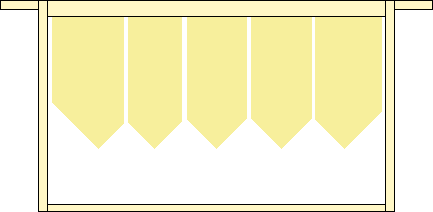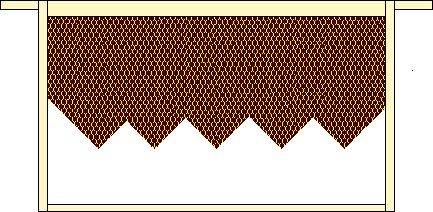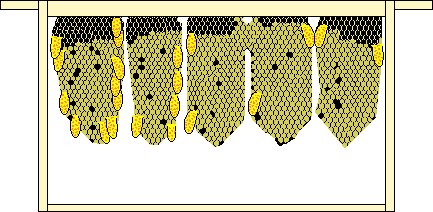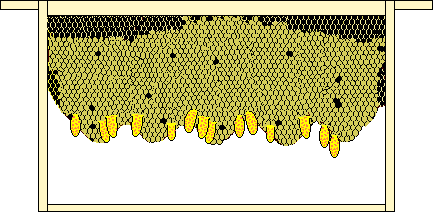Many amateur beekeepers don't rear their own queens because they find the most common method and the one most often advised, grafting, is quite difficult to do. I have given many demonstrations and workshops and I reckon 20% of attendees pick it up easily, the rest don't, so give up quickly. Dexterity, eyesight and a "mental barrier" seem to be the main problems.
There are alternatives that don't involve handling larvae, one of which is the Miller Method. This is a simple method that has been in existence since the early 20th century. It was devised, possibly as an adaptation of an earlier method, by the American Dr. C.C. Miller, who also designed the Miller Feeder and other items of equipment, including queen introduction cages. It appears there were several beekeepers who found different ways of achieving similar results prior to Miller and there have been variations since. They have all become known as the "Miller Method" and I will stick to that to avoid confusion.
The Principle.
Shaped comb or foundation is placed in the middle of a brood box of a selected colony. The queen lays in it and the bees extend the bottom and fill the gaps, allowing the queen to lay in the extensions a few days later. When the eggs start to hatch it is removed from the colony, the bees removed and the comb is cut back to where the larvae are 24 - 36 hours old, i.e. 4 - 4 ½ days from the egg being laid. The comb is then placed in a cell raising colony and the bees build Q/Cs on the exposed edge.
Miller used triangular strips of foundation that were about 1 ¼" - 1 ½" wide at the top and cut to a point about 1 ½" from the bottom of the frame, with gaps of about 2" in between. The bees draw out the strips of foundation individually and the queen lays in them before the gaps are filled. This makes it easy to cut back to larvae of the right age. I have seen other shaped strips used including parallel with a 90° point on the bottom, similar to Illustration 1. below.
The four illustrations below were made by Dave Cushman and although they are not particularly accurate, they give a reasonable idea of what can be achieved.

How to do it.
Illustration 1. The drawing on the right is of strips of foundation that is a variation of what was used by C.C.Miller. If the foundation isn't wired it would be fairly fragile and the frame would have to be handled with great care to prevent distortion.
The hive that the frame is placed in should be level, so the strips of foundation hang vertically and not get bridged across to the flanking frames.
It is my view that five strips is too many for a B.S. frame. I think Dave Cushman probably drew it from a photo of a Langstroth frame that is bigger, although I have seen a photo that may have been Miller's that had four strips in what was presumably a Langstroth. I would suggest only three in a B.S. frame. We must also remember that Miller probably had conditions where the bees would build many more Q/Cs. In U.K. conditions with my bees, I don't allow a colony to raise more than 15 Q/Cs, so you don't need the larger number of larvae exposed.

Illustration 2. I prefer drawn comb to foundation in U.K conditions and virgin comb if possible. If comb has had brood in it, or more than a couple of generations, it tears, rather than cuts cleanly. I cut a B.S. comb with just two points and find this adequate. The drawing on the right is attempting to raise far more queen cells than the average colony in the U.K. will produce. I cut the "V"s to shape with a sharp knife or scalpel.

Illustration 3. The queencells in this illustration are exaggerated in size, but the positions that they are shown in were taken from an actual comb. This is what should be achieved when using strips of foundation as in Illustration 1.

Illustration 4. The queencells in this illustration are also exaggerated in size, but the illustration has been synthesised rather than depicting an actual ragged old comb. This is roughly what to expect from a comb that is cut in a similar way to Illustration 2.
My experiences with the Miller Method in U.K. conditions.
I have used the Miller method a lot and have had two main problems with it. Firstly poor information and secondly weather related issues. I read books and articles and listened to lectures, until it finally dawned on me that some of what was written or said was misleading, probably due to one of the usual problems with beekeeping - writers who had little or no experience simply copying from elsewhere, including the mistakes, or speakers telling the audience what was in the books!
The Miller method is very simple and successful once you have cracked it and, if conditions are right, but it can often go wrong. I have found it to be rather less reliable than other methods. If you are an amateur beekeeper who only wants a few queens and you can handle a possible delay, or produce an unknown number of Q/Cs, then it is perfectly adequate for your purposes, but if you want a known number of Q/Cs for distribution on a certain date, then use another method.
Queen cells built using the Miller method are effectively emergency cells and may not be started at the same time. This means the timing of emergence is not as accurate as some other methods. Don't be fooled by them being emergency cells, I usually get good quality Q/Cs and queens and am happy to give lectures and demonstrations to encourage others to use the method because it has the following merits.
- It is simple with no techniques to be learnt
- No extra equipment is needed
- There is little or no cost
I have indicated the Miller method can be unreliable and I think I should explain some of the reasons why, so the beekeeper who tries it can understand why they may not have the expected success and not blame themselves. Many writers and speakers will give the impression everything works fine in U.K. conditions, but that just tells me they may not use it on a regular basis, if at all. It never seems to be a main subject, but an addition, giving me the impression they are simply bulking out their article or presentation. I have spoken to many beekeepers who have had the same experiences as me and given up. For that reason I give my experiences in the hope it will encourage them to try again.
Miller was an American working in better climatic conditions than we do in the U.K. and I suspect results are usually good there.
I don't know how many times I have heard that all you do is put a whole comb or sheet of foundation in a colony to get the queen to lay in it, then cut back in a zig-zag shape. It doesn't work like that! What happens is the queen lays in the centre of the comb first, then moves outwards, so the oldest larvae are in the centre. Cutting a zig-zag will simply cut through larvae of different ages.
I find that foundation can be unreliable. If there is no nectar coming in the bees won't draw it, if a lot comes in they will draw and fill it with nectar. With foundation the bees have to draw it first, but they don't do the whole sheet at the same time if nectar income is fairly low. This can mean the queen lays in the comb over several days and the larvae are different ages. You seem to need a steady nectar flow. I have had far more success with drawn comb, as the queen lays more evenly because the comb is already built. Virgin comb is preferable to that which has had brood in, as it can be difficult to cut through the tougher cocoons and the bees draw out queen cells better on new comb. I no longer use foundation.
I think it may be better to put the frame in a smaller colony that is strong in bees to get the queen to lay it up, as I have had good success with a 5-8 frame colony. Quite often I find the full honey producing colony will not always do as you expect.
I like to get my brood combs drawn out above a queen excluder by using brood boxes as supers. At extraction I uncap parallel to the frame, which gives me good drawn comb. Occasionally, there are some that aren't drawn perfectly and these are ideal for using for the Miller method. The wiring is no problem, as I can easily cut round that. I have used super combs on occasions and these work well, providing you leave enough room so the Q/Cs don't get fixed to the bottom bars of the frame. If you are working your bees for cut comb honey, you often get part drawn combs at the end of the season that may not be suitable for cut comb the following year, but they are ideal for the Miller method.
I cut the zig-zag first and I only use two peaks in a B.S. frame. This gives two areas for the queen to lay in, where she will lay in the centre of each area and work outwards, rather than in the centre of a whole comb. The bees will then extend the comb and the queen will lay in that a few days later. The comb can be cut along a line where the larvae are the right age, but this is usually not in the straight line often indicated - the shape doesn't matter. If you have a delay, you may be able to use the extension that should be a day or so behind, but be careful, as often the extensions are drone comb, especially early in the season.
If the whole sheet of foundation or comb is put in, you will probably have to cut a different shape, it doesn't matter, it still works, so it's not a disaster.
Feeding to simulate a nectar flow is possible, but not easy if the colony has supers. The feed needs to be controlled, not rapid, otherwise the bees will fill the comb with syrup.
You don't know how many Q/Cs you will get, as this largely depends on the peak queen cell number (PQN) of the cell raising colony, but this adds a bit of interest! I don't destroy some larvae on the edge of the cut as is often advised, as I find there is no need to. Cells are often joined, but I simply pinch out the poorer one. Bees occasionally build emergency cells on the face of the comb and I usually remove them, unless I am short of Q/Cs, in which case I may leave one on the comb for the cell building colony.
On more than one occasion, I have had a colony prepare to swarm when a Miller comb is in a colony, where I found they built cell cups on the edge of the comb, making them look like emergency cells. These can be utilised if needed.
Very often, you may have an old or failing queen that is good and you want to get a few extra queens from her. The Miller method may be unsuitable because she probably won't be laying a good enough pattern and another method would be more suitable.
Despite the few problems I have found with the Miller method, I still think it is a very good method for the ordinary amateur beekeeper, who is not rearing queens to a strict timetable. If it goes well, it is as good as any system and certainly produces excellent queens. If it goes wrong, it doesn't matter too much because you can do a repeat. I hope the few problems I have highlighted may help others.
Originally written by Dave Cushman. Rewritten by Roger Patterson.
Page created pre-2011
Page updated 18/12/2022